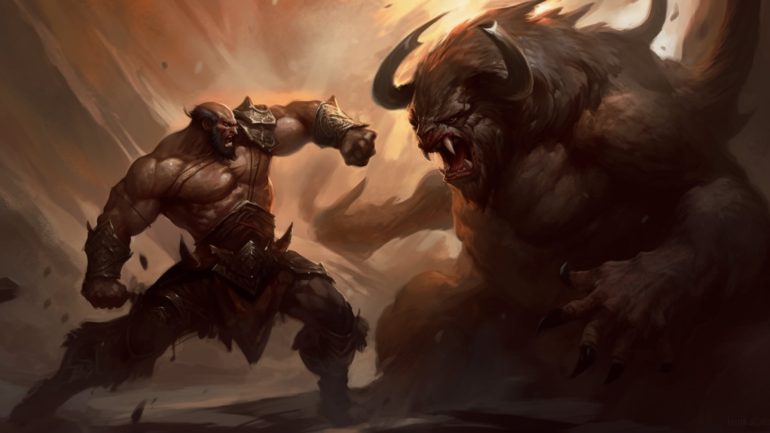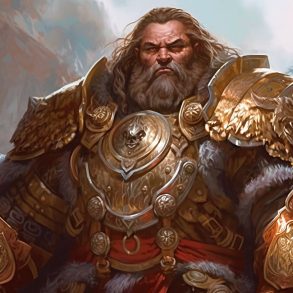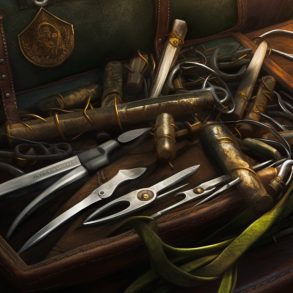Sometimes you may find yourself without a weapon to hand, playing a hand-to-hand specialist like a Monk, or really wanting to headbutt the individual in front of you, all of which means you’ll want to make an Unarmed Strike (PHB, p. 149), so let’s go through the ins and outs of socking it to ‘em.
How do Unarmed Strikes work in 5E?
An unarmed strike is an attack with a part of your body, such as a punch, kick, headbutt, or any other forceful blow. You’re always proficient with your unarmed strikes, which are melee weapon attacks, and deal 1+ your Strength modifier. As the damage for unarmed strikes is a flat number not a die, they do not gain additional damage from critical hits. If you have a negative Str modifier then you will do 0 damage on a hit with your unarmed strike unless you can add damage to it from elsewhere, such as the Hex spell.
An important distinction is that whilst unarmed strikes are melee weapon attacks, your body does not count as a weapon unless you have a feature that explicitly says it does, e.g. like the Path of the Beast Barbarian’s natural weapons. This is weird and confusing but stems from melee attacks having to fall into one of two categories:
- Melee weapon attack – A physical attack that uses Strength, Dexterity, or Constitution for the attack and damage modifiers unless you have a feature that allows a mental ability score to be used instead. The Attack action uses this kind of attack if you are within melee range. On rare occasions a spell might specify this kind of attack instead of a spell attack, like Booming Blade.
- Melee spell attack – An attack created by a spell or feature, that uses your spellcasting modifier for the attack roll and the damage modifier if there is one. Spells like Shocking Grasp and Vampiric Touch use melee spell attacks.
An unarmed strike isn’t a spell or magical feature and is used with the attack action, so it has to fall under melee weapon attack, even though you’re not using a real weapon. This is important, as some spells and abilities only require a melee weapon attack, whereas others may require an attack with an actual melee weapon.
A good example of this is the Paladin:
Divine Smite requires you hit a creature with a melee weapon attack, so you can use it with an unarmed strike.
Improved Divine Smite requires you hit a creature with a melee weapon, thus you wouldn’t benefit from the additional damage on unarmed strikes.
This also applies to spells like Magic Weapon, you wouldn’t be able to use it to enhance your unarmed strikes like you could with a weapon like a longsword.
How can you improve your Unarmed Strike damage?
One of the easiest ways to improve your Unarmed Strike is to change the damage from a flat 1 to a die. This not only increases your average and maximum damage but also allows you to benefit from the additional damage critical hits can provide.
Note – I won’t get into additional damage modifiers that are compatible with unarmed strikes (like Divine Smite and Hunter’s Mark) here, this list is purely to improve the unarmed strike in its base form.
Anything marked with * is not considered as making an unarmed attack but is included within the list for completeness as it fits the imagery of an unarmed strike.
- Monk – At 1st level, the Monk’s Martial Arts feature allows you to use Dexterity for your unarmed strikes and allows you to use a d4 for damage, leveling up as a Monk provides a larger die size at every new tier, letting you to go as high as a d10 at 17th level. This feature also allows you to make an unarmed strike as a bonus action, as long as you meet the requirements of the Martial Arts feature.
- Alter Self (spell) – You can use this spell to give yourself a natural weapon that will deal 1d6 + Str, as well as adding +1 to the natural weapon’s Attack Bonus and damage, and this weapon is considered magical. The damage type for this weapon is bludgeoning, piercing, or slashing depending on what is appropriate for the type of weapon created, e.g. slashing for claws.
- Tavern Brawler (feat) – This feat will increase your damage to 1d4, and allows you to grapple as a bonus action if you hit a creature with an unarmed strike using your action.
- Dragon Hide (feat: Dragonborn only) – In addition to its main benefits, this feat gives you retractable claws you can use for unarmed strikes, increasing the damage to a d4.
- Insignia of Claws (magic item) – This magic item gives you a +1 to attack and damage rolls with unarmed strikes and natural weapons, making them magical as a result.
- Eldritch Claw Tattoo (magic item) – Similar to the Insignia, this Tattoo makes your unarmed strikes magical and adds +1 to attacks and damage. In addition, once a day you can empower your unarmed strikes as a bonus action, increasing the range from 5 feet to 15 feet and adding an additional 1d6 force damage to each hit. Unlike the Insignia, this will not affect a natural weapon unless it is able to be used for unarmed strikes.
Races that provide natural weapons:
- Aarakocra – Talons that deal 1d4 + Str slashing damage.
- Centaur – Hooves that deal 1d4 + Str bludgeoning damage.
- Dhampir* – A bite that deals 1d4 + Con piercing damage.
- Leonin – Claws that deal 1d4 + Str slashing damage.
- Lizardfolk – Bite that deals 1d6 + Str bludgeoning damage; can make a bonus action bite once per rest that grants temp hp equal to your Con mod.
- Minotaur – Horns that deal 1d6 + Str piercing damage; allows you to make a bonus action attack when you take the Dash action.
- Satyr – Horns that deal 1d4 + Str bludgeoning damage,
- Shifter (Longtooth) – Fangs that deal 1d6 + Str piercing damage as a bonus action whilst shifted. It’s not explicitly stated these can be used for your action in the text, so make sure to check with your DM.
- Tabaxi – Claws that deal 1d4 + Str slashing damage.
- Tortle – Claws that deal 1d4 + Str slashing damage, and yes, a wasted opportunity to make them snapping Tortles.
Hopefully, this short trip to the dojo has improved your form ready for the next tavern brawl, if you’re interested in unarmed strikes, check out our Monk 5E guide. Good luck on your unarmed adventures and remember to keep your chin tucked in!






